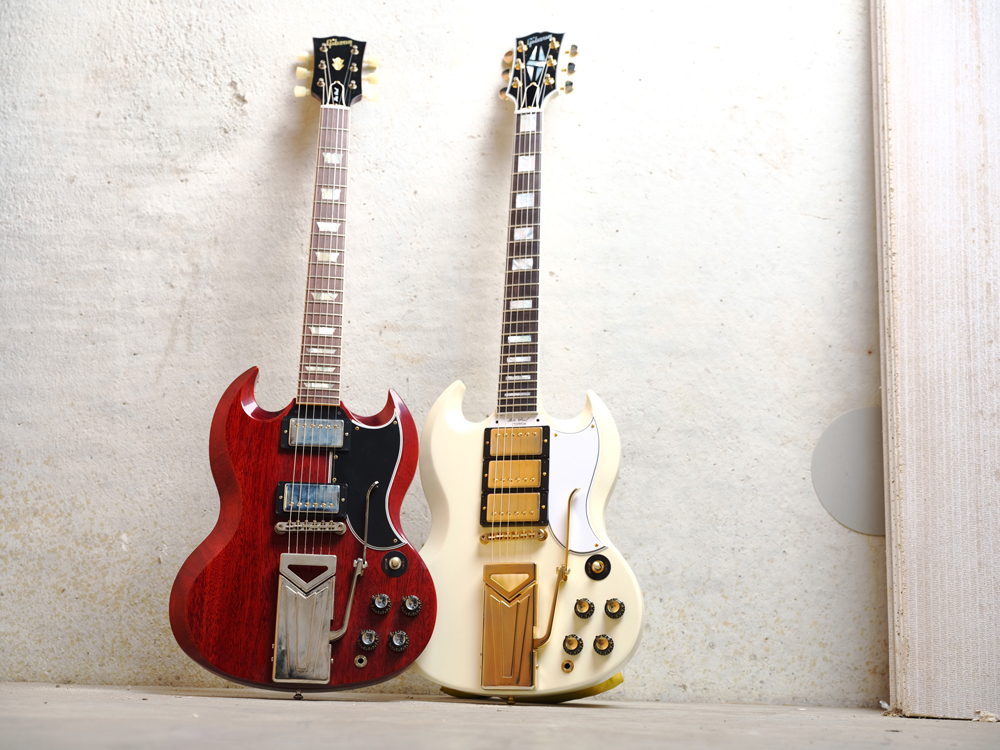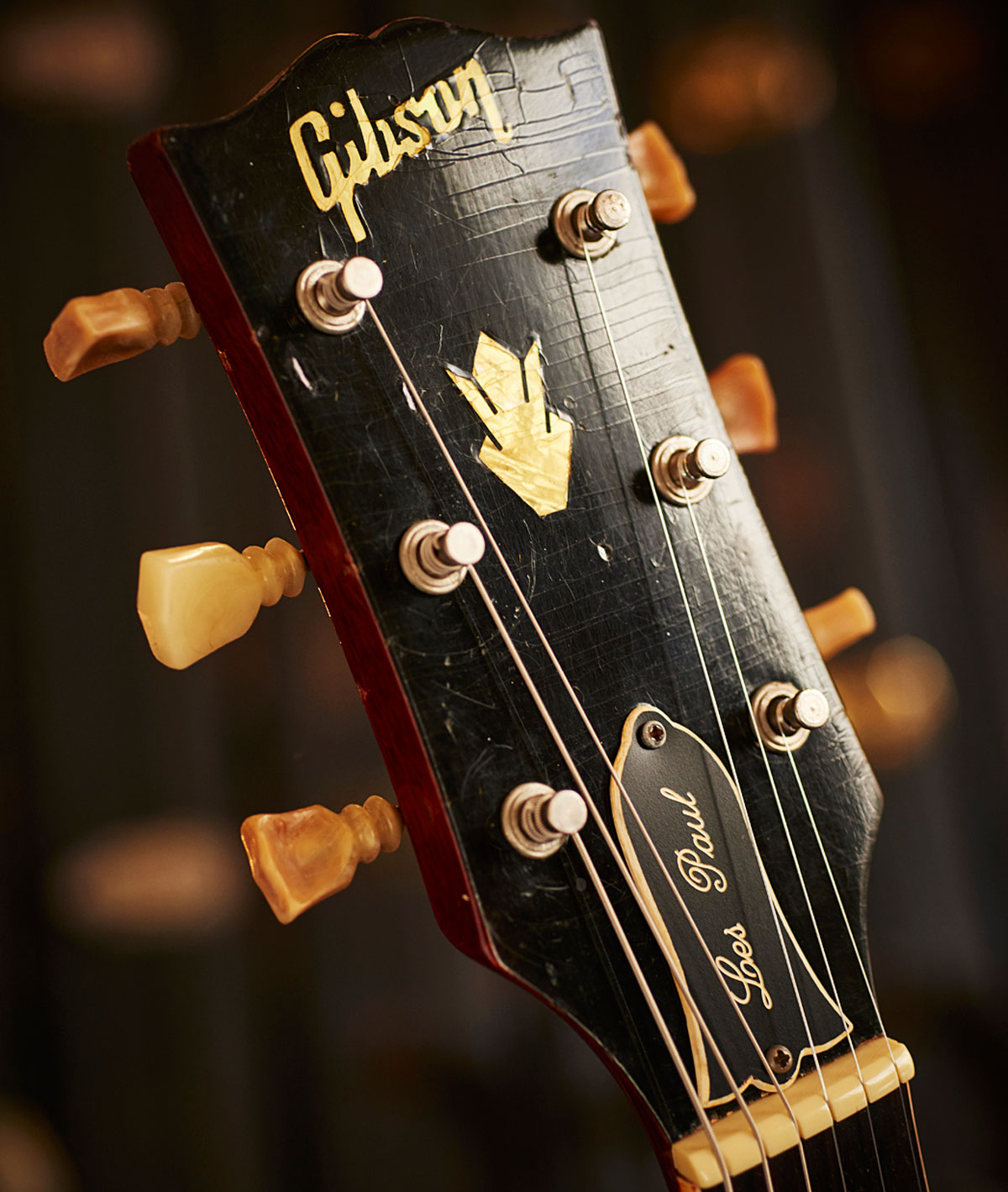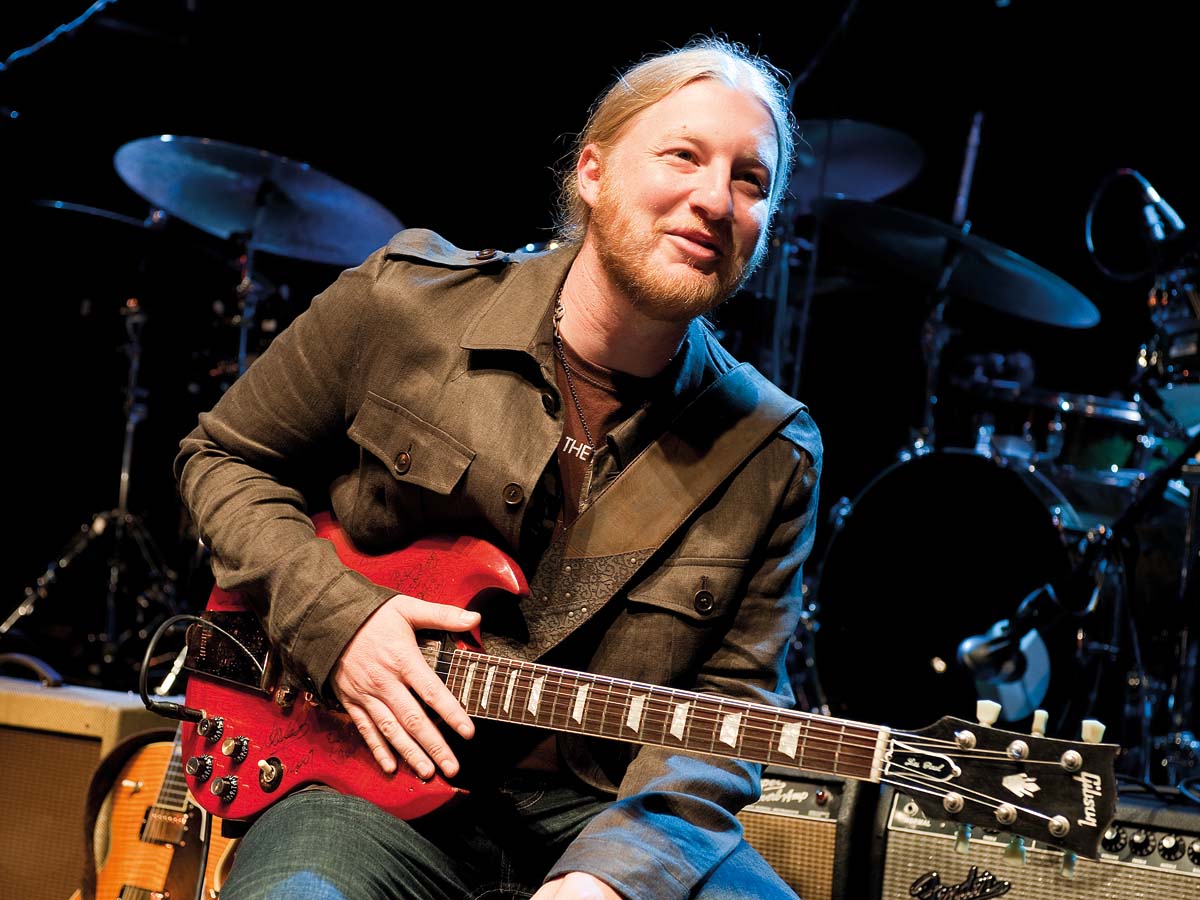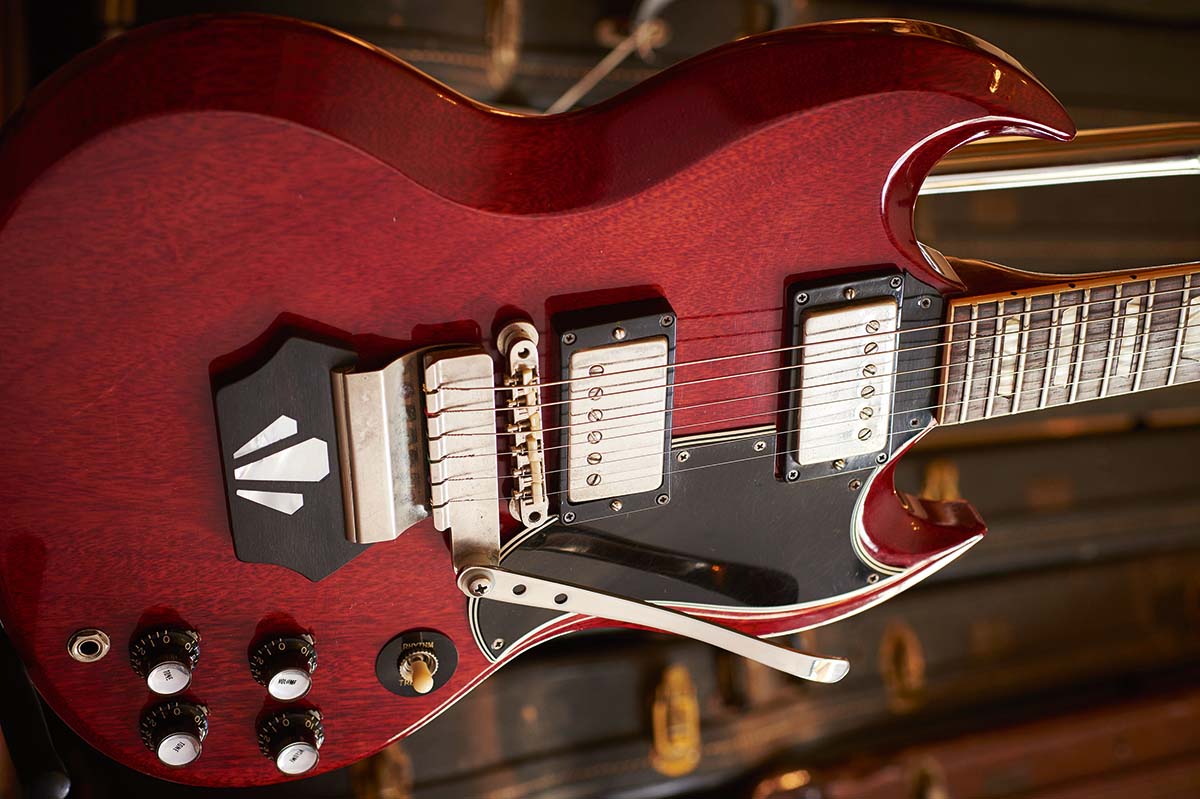The story of the Gibson SG: the first two decades of the Les Paul's double-cutaway successor
At the tail-end of the 1950s, Fender’s Stratocaster was reigning supreme over the electric-guitar market. Kalamazoo needed to fight back...

The Gibson SG design, officially launched in 1961, was a radical departure for the solidbody electric guitar, almost as if a sculptor had been at work rather than a guitar maker.
The body was a stylish blend of bevels and points and angles, and the relatively lightweight instrument invited players to reach its topmost frets with ease and speed thanks to a pair of pointy cutaways. It was unlike anything any company had produced before – even if the shadow of Fender was evident across some of its ideas.
Gibson’s motivation to introduce this new design seems almost beyond belief in retrospect. The idea was to replace the original single-cutaway Les Paul. That’s correct.
Managers at the firm saw sales dipping, so to them the solution was obvious: ditch the earlier Les Paul design completely and bring in a new Les Paul design. And that’s correct, too: a new Les Paul design. Because at first, most SGs were called Les Pauls. Confusing, isn’t it? We’ve hit on a major headache for anybody interested in the story of the early SG, so let’s get it out of the way before we proceed.

The fact is that, despite the big switch to an almost entirely different guitar, Gibson kept the Les Paul name for the first few years on many of the new SG-design models. To understand how this unfolded, we have to consider the three broad changes leading up to the introduction of the new SG design.
First, the budget Les Pauls were changed from their original single-cut style to a rounded-double-cut style (not the SG shape). The Les Paul Junior and TV moved in ’58, the Special in ’59. Second, Gibson gradually renamed ‘Les Paul’ models as ‘SG’ models. The company started removing Les Paul’s name from guitars in 1959 because it felt the association had become less valuable commercially.
So the rounded-double-cut Les Paul TV and Les Paul Special were renamed the SG TV and SG Special in ’59. Finally, there was a shift of all the Les Paul models to the new SG shape: the Les Paul Standard late in 1960, the Les Paul Custom, Les Paul Junior, SG TV and SG Special in ’61.
Get The Pick Newsletter
All the latest guitar news, interviews, lessons, reviews, deals and more, direct to your inbox!

It’s hardly surprising that players and collectors have since tried to simplify this information. It’s become easier to call a Les Paul-shape guitar a Les Paul and an SG-shape guitar an SG.
And an SG-shape guitar with the Les Paul name somewhere on it – which means one made between late 1960 and late 1963 – is usually called an SG/Les Paul (or Les Paul/SG). Got all that? However, towards the end of 1963, thank goodness, the new SG-shape Les Paul Junior, Les Paul Standard and Les Paul Custom were renamed the SG Junior, SG Standard and SG Custom. Headache over, once and for all. Hopefully.
Thinner & Double-Cut
Several trends of the late 50s at Gibson fed into the new solidbody intended to take the 60s by storm. That launch of a new rounded-double-cutaway body for the budget Les Pauls, for example, was a practical and apparently humble design change, made because it was becoming apparent to Gibson how useful double-cutaways were.
The ES-335 was a major launch in 1958, a development of a stylistic change in the hollowbody electric lines that had started a few years earlier with the Byrdland, ES-225T and ES-350T. They had a new slimmer ‘Thin Body’ style that aimed to be more comfortable than the existing deep-body cutaway electrics, combining solidbody leanness with hollowbody tradition.
Also, the Byrdland and 350T had slimmer necks, and that idea began to spread to a few other models, including the revised single-cut Les Paul Standard, which since ’58 was finished in Sunburst and during 1960 shifted to a slimmer neck profile.

The 335 is mentioned in guitar histories mostly for its revolutionary centre-block body, but it had another notable feature. “It’s a double-cutaway,” said Gibson in ’58, “for nothing less than complete accessibility to the fingerboard.”
And the same year, for that new rounded-double-cut body on the low-end Les Pauls, Gibson said this provided “maximum access to all 22 frets. This is a feature every guitarist desires – to reach full chords down the entire length of the neck. All music becomes easy and effortless with the new double-cutaway.”
Beyond the Gibson factory, some guitar fans started to wonder if the brand was falling behind the times. Those mavericks at Fender over on the West Coast were selling more and more of their bright, modern Stratocaster. There was a growing impression that Fender had the style and attitude needed to make the guitars of the moment.
Gibson wanted to compete, but its first attempts, the oddly shaped “Modernistic” Flying V and Explorer of ’58, famously failed to grab guitarists at the time.
The firm was still searching for a solidbody design to rival Fender’s contoured, body-hugging Strat. In 1960, with Les Paul sales flagging despite the changes, Gibson’s managers got together and decided to stop messing around and instead devise a completely new solidbody design.

A Solid Guitar Is Born
There’s no evidence to tell us who chose the new name to replace ‘Les Paul’, but whoever it was, they went for simplicity.
The new name was ‘SG’. It stood, modestly enough, for ‘Solid Guitar.’ Maybe it was Larry Allers, who supervised and co-ordinated the work on the new design? He’d worked at Gibson since the 1930s and was made chief engineer in woodworking after the success of the Les Paul Goldtop in 1952.
For this project, the team took on several of the recent trends at Gibson, including thinner and double-cutaway bodies, new finishes, slimmer-profile necks with full access to the highest frets, and humbucking pickups. Also, they leaned on some of Gibson’s established features and methods.
Eventually, a finished prototype appeared. It was tested by a few guitar-playing employees, and Gibson’s sales people were consulted, too. The official announcement of the first two new models, the Les Paul Standard and the Les Paul Custom, came in 1961, although the new Standard had started to roll off the line at the very end of 1960.
By the time the July ’61 NAMM trade show was held in Chicago, Gibson had its full set of brand-new SG-style solidbodies to show off: the Les Paul Junior, Standard and Custom, and the SG TV and Special.
The firm’s price list noted the Junior, Junior Three-Quarter and TV each at $142.50, the Special at $195, the Standard at $265, and the Custom at $395. Gibson had dropped the original-style single-cut Les Pauls – the Sunburst Standard and Black Custom – as well as the rounded-double-cut Cherry Les Paul Junior and Junior Three-Quarter, and the rounded-double-cut ‘limed’ SG TV, Cherry or Cream SG Special, and Cherry SG Special Three-Quarter.

Features & Specs
The Les Paul Standard in its thoroughly new SG guise was an attractive addition to Gibson’s catalogue. The Cherry-finish body was a solid piece of mahogany fashioned into a slim, handsome shape. There was a large cutaway on the bass side and a slightly smaller one on the treble, and the horns were shaped to graceful points. It made for a lighter guitar than a single-cut Les Paul.
The edges of the body had bevels (aka scarfs or facets) of around 22 degrees – along the edge of the bass side, front and back; the same inside both cutaways; and along the forward part of the edge of the treble side, front and back, following the line of the pickguard. The bevels, which made the body seem even thinner than it was, formed a recognisable, useful and attractive feature of the SG design.
The thin neck was also mahogany, but the position of the neck-pickup rout and the thinness of the body meant there was little of the neck tenon to secure, and this proved a weakness, with cracks and breakages around the neck joint relatively common. Gibson tried to remedy this as the 60s wore on, the efforts visible where the neck met the body at the back: sometimes the joint was relatively smooth; more often there was an evident step.
Another weak area on early models centred on the output jack behind the control knobs, where there was little wood to support it, and cracks had a habit of appearing around here, too. There was a separate vibrato tailpiece, which Gibson called a Vibrola and everyone else called a sideways vibrato (or, very often, something much less polite). A Gibson catalogue said it “operates in direction of pick stroke; swings out of way for rhythm playing”.
A foldable arm was connected to a mechanism (under a cover with handsome deco-style ornamentation – one of the nicest things about this Vibrola) where the strings fastened to slots at the top. When the arm was rocked sideways, rather than the usual up-and-down vibrato action, two large springs moved the string anchor. The Vibrola’s shortcomings soon became apparent, mainly that it often failed to return the strings to correct pitch.
The foldable arm turned out to be a useful feature, though, because after some initial stumbling, many players folded it out of the way and left the vibrato untouched. The Standard’s new high-end neighbour, the Les Paul Custom, kept the upper-crust qualities that had always marked it out as something exceptional in earlier single-cut days.

Now it had a gleaming white finish (including the neck), gold-plated metalwork (including the arm and cover of the sideways vibrato), and three of those lovely humbuckers. The Custom’s pickguard matched the white finish, and, like the Standard, it had a little strip between the neck pickup and neck.
The Standard had the Les Paul name on its headstock, but the Custom had it on this strip. Gibson’s customary indications of a top-end model were present: a split-diamond inlay at the headstock; an ebony fingerboard with block pearloid markers; and Grover Rotomatic tuners with metal kidney-bean buttons.
The Custom looked as if it had the same four controls and selector switch as the Standard, but this was a three-pickup guitar. Looking down as you played, the three-way selector offered neck pickup alone (switch left), bridge and middle pickup together (centre), or bridge pickup alone (right).
The two nearest knobs were for neck pickup (volume on the left, tone to the right), and the two below for bridge or bridge-and-middle, depending on the selector position (and again, volume on the left, tone to the right). Like some other three-pickup guitars that co-opted a two-pickup control layout, it was something of a compromise, but once you got your head around the combinations it worked reasonably well.

The new-shape Special, Junior and TV sat at the lower end of the SG-style list, with one (Junior, TV) or two (Special) P-90 single-coils. At first, all three came stock with Gibson’s wrapover stopbar, an angled bar-shape combined bridge-and-tailpiece, but an optional version was offered with a separate six-saddle bridge and vibrato tailpiece.
At first, this vibrato was Gibson’s simple Maestro Vibrola, with a rounded rectangular frame, curved string mount and, usually, a nameplate. Double-neck SGs followed in 1962, replacing the thinline hollowbody models first offered in ’58. Like those, they were custom-order only, and very few were ever made.
There were three variations, with the EDS-1275 Double 12 having a six-string and 12-string neck. While, the EMS-1235 Double Mandolin had a regular six-string neck plus a short-scale neck with eight strings in four courses, like a mandolin. Although a few had a short neck with six strings tuned an octave higher than a guitar, supposedly to mimic the sound of a mandolin.
Lastly, the EBSF-1250 or EBS-1250 Double Bass paired a regular six-string with a four-string bass neck (and, unlike the other two models, there had been no equivalent in the earlier hollowbody line). At first, the EBSF variant came with a built-in Maestro Fuzz-Tone.

Amending The Templates
Gibson made some alterations to the SG-style models following their launch at the start of the 60s. There were moves to try to overcome the problems associated with the sideways vibrato originally fitted to the Standard and Custom.
A few guitars around ’62 had a ‘short’ Vibrola, with regular up-and-down vibrato action and an inlaid black ebony block attached under the base of the tailpiece. A few others from that time came with a Bigsby B5 tailpiece (the short horseshoe-shape variety).
During ’63, Gibson settled on the Deluxe Vibrola (or ‘long’ Vibrola) for the Custom and Standard. It was more or less the same as the short Vibrola, but with a long metal plate rather than the smaller ebony block. The plate was decorated with a lyre-and-leaves motif and a Gibson logo.
As we’ve seen, the Special and Junior/TV started life as standard with a single wrapover stopbar (combined bridge-and-tailpiece) or an optional Maestro Vibrola, but that soon shifted to a short Vibrola (without block) plus bridge, which became the standard fitting for those models around ’65.
There was also a continuing effort to improve the strength and stability of that rather weak neck joint. The changes had worked reasonably well, and by 1966 the neck joint was the strongest so far, with a distinctly higher overlap of the body wood at the rear.
Also at that time came a major visual change with the arrival of a much larger pickguard – which, in hindsight, proves useful to identify original instruments from this later-60s period. Until the change, the pickguard had been a relatively small one that sat, in traditional fashion, between the pickups and the lower edge of the body (sometimes called an ‘angel-wing’ pickguard). the shape.

The new pickguard of ’66 completely surrounded the pickups, sitting either side of them, in the process disposing of the small separate strip that some models had between the neck pickup and the end of the neck. The new big ’guard is often called a ‘batwing’, again for the shape.
The large pickguard was fitted to all four SG models: Custom, Standard, Special and Junior/TV. Also, for the Custom and the Standard the factory now usually made a larger all-purpose rout in the body with space for up to three pickups – a sizeable hole usefully hidden by the new batwing.
There was a move in the later 60s to chrome plating, plus a small decrease in the nut width, and the addition of a volute, a triangular lump just below the point where the neck rear becomes the headstock, designed to reinforce another notoriously weak spot.
A slight decrease was made in the angle at which the headstock tipped back from the neck, aiming to minimise problems in the same area. Such practical changes did nothing to enhance Gibson’s reputation among those who had started to think that older guitars might be a better bet than the firm’s current offerings.

70s Styles
After a peak in SG sales in ’65 and then a pretty sharp decline, mirroring the industry’s general woes, there was a surge in ’69 and ’70, with 6,677 SG Standards shipped in that latter year.
This was almost as many as the previous four years combined, and a figure that would remain unmatched for the rest of the 70s. Gibson, owned since 1969 by Norlin, made big changes to the SG line in the 70s. In ’71, the company stopped using the Standard and Special names, although it kept the Custom name.
For the Pro (a revised and renamed Special), Deluxe (revised and renamed Standard) and Custom, the most obvious visual ID was a move to a semi-circular plate on which the controls and jack were mounted. The big pickguard of ’66 was replaced by a regular-size guard slightly raised from the body. The bevels had gone from the inside of the cutaways and the headstock was slightly larger.
The bevels, which made the body seem even thinner than it was, formed a recognisable, useful and attractive feature of the SG design
Gibson boasted the new models had three-piece laminated mahogany necks, a volute, and what it called “90 degree neck pitch” – meaning the plane of the neck was parallel to the plane of the body, rather than the earlier style where the neck leaned back slightly, and the fingerboard was higher off the body. The neck had been shifted further into the body and the bridge was shifted a little further down. It all added up to a different and sometimes awkward feel.
In 1972, the SG Special and Standard names reappeared, and by ’73 the line had settled into a new-look Special, Standard and Custom, dropping the parallel neck construction and the semi-circular control plate and returning the bevels in the cutaways, providing a rather more traditional feel and look. The Special would be dropped in ’77, which left the Standard and the Custom as the sole mainstream SG models in the Gibson line in the remaining years of the 70s.
Onward With The SG
It wasn’t until the 80s and 90s that Gibson began to acknowledge the greatness of the original SG design through the release of reissues and vintage-vibe recreations, and SGs started to regain their position in the Gibson line as strong solidbodies alongside the Les Pauls, which had been back in the Gibson catalogue since 1968.
Players rave about the extra slim neck with the low, smooth frets that is such a joy to play – the action is so easy, players also refer to it as the ‘Fretless Wonder’
Gibson, circa 1961
In 1961, when Gibson introduced its dealers to what the company called the “completely redesigned” Les Paul/SG models, it summed up the attractions of the new guitars. It said the Standard was “now offered with completely new styling… thinner, lighter in weight, and custom contoured. A wonderfully designed solid body, perfectly balanced for playing in a standing position.”
And for the Custom, too, Gibson’s pride was evident: “A new, revolutionary body design, exquisite craftsmanship and deluxe features,” ran the blurb, “ultra thin, hand contoured, delicately balanced design … Players rave about the extra slim neck with the low, smooth frets that is such a joy to play – the action is so easy, players also refer to it as the ‘Fretless Wonder’.”
Throughout its long eventful life, the SG has almost always had to contend with the dark shadow cast over it by the Les Paul. Of course, it’s impossible to think about the SG as just one guitar. Today, there’s a whole range of contemporary feature combinations and vintage periods to choose from. Just cast aside any notions of the SG as some kind of also-ran. Long live the Solid Guitar!
“It holds its own purely as a playable guitar. It’s really cool for the traveling musician – you can bring it on a flight and it fits beneath the seat”: Why Steve Stevens put his name to a foldable guitar
“Finely tuned instruments with effortless playability and one of the best vibratos there is”: PRS Standard 24 Satin and S2 Standard 24 Satin review



![A black-and-white action shot of Sergeant Thunderhoof perform live: [from left] Mark Sayer, Dan Flitcroft, Jim Camp and Josh Gallop](https://cdn.mos.cms.futurecdn.net/am3UhJbsxAE239XRRZ8zC8.jpg)









